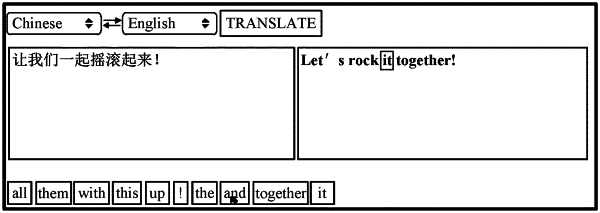| CPC G06F 40/56 (2020.01) [G06F 40/51 (2020.01); G06F 40/53 (2020.01); G06F 40/58 (2020.01)] | 12 Claims |

|
1. An interactive machine translation method, applied to an electronic device, comprising:
receiving, using a graphical user interface, a source statement input by a user;
translating, using a translation model, the source statement into a first target statement, and displaying, using the graphical user interface, the first target statement;
determining whether the user performs a selection operation on a first vocabulary in the first target statement displayed using the graphical user interface;
in response to determining that the user performs the selection operation on the first vocabulary in the first target statement displayed using the graphical user interface, determining that the user adjusts the first vocabulary in the first target statement;
acquiring, from an intermediate result of the translation model which is generated in a process of translating the source statement into the first target statement, a second vocabulary for replacing the first vocabulary, or receiving, using the graphical user interface, a second vocabulary input by the user for replacing the first vocabulary; and
adjusting, using the translation model, a vocabulary sequence located in the front of the first vocabulary and a vocabulary sequence located behind the first vocabulary in the first target statement based on the second vocabulary to generate a second target statement;
wherein the translation model is a neural network-based model;
wherein adjusting, using the translation model, the vocabulary sequence located in the front of the first vocabulary and the vocabulary sequence located behind the first vocabulary in the first target statement based on the second vocabulary to generate the second target statement comprises:
adjusting, using the translation model, the vocabulary sequence located behind the first vocabulary as a first vocabulary sequence based on the vocabulary sequence located in the front of the first vocabulary in the first target statement and the second vocabulary;
adjusting, using the translation model, the vocabulary sequence located in the front of the first vocabulary as a second vocabulary sequence based on the second vocabulary and the first vocabulary sequence; and
generating the second target statement based on the second vocabulary sequence and the first vocabulary sequence.
|